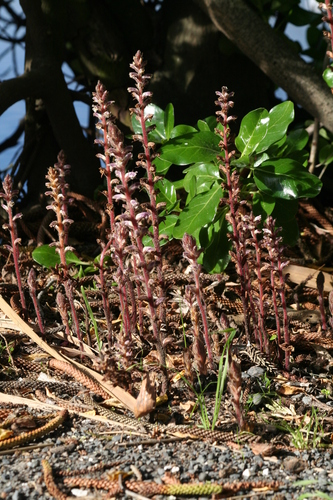common broomrape
Orobanche minorSummary 6
Orobanche minor, or Common Broomrape, is a holoparasitic angiosperm belonging to the genus Orobanche; a genus of about 150 non-photosynthetic plants that parasitize other autotrophic plants.
Taxon biology 7
Common broomrape is a parasite. You won't find any green in this plant because it contains no chlorophyll. That is why it needs a host plant in order to obtain the necessary nutrients to grow. Its favorite host plant is red clover, although it can also parasitize on all kinds of pea family species and occasionally other random plants.
Hosts and speciation 8
The common broomrape is highly generalist in its host range, and can infect hundreds of species in families from the Ranunculaceae to the Poaceae (=Gramineae) but with a clear preference for the Fabaceae (=Leguminosae) and Asteraceae (=Compositae). However races occurring on different species of host are genetically divergent and physiologically adapted to their local hosts, and may therefore be in a state of incipient speciation. Urgent conservation efforts are required as the survival of some intraspecific taxa is very uncertain.
Characteristics and growth requirements 8
O. minor grows to 0.5 m (1 ft 8 in) and is a perennial. The flowers are hermaphrodite.
Common broomrape grows in a wide variety of soils, namely moist, light (sandy), medium (loamy) and heavy (clay) soils that are acid, neutral or basic. It can grow in semi-shade or in full sunlight.
The species appears in a wide range of colours from red-brown, yellow-brown to purple. Yellow specimens are also not uncommon and it's this extreme variability that makes identification on the basis of size or colour uncertain.
Common broomrape is parasitic on various members of the pea (Fabaceae) and daisy (Asteraceae) families. Although widespread, its appearance is sporadic; despite this it can occur in vast colonies from time to time. The main flowering season is from May until the end of August. The species has efficient seed dispersal and is largely inbreeding so that populations preferentially parasitizing a particular species which has its own clear ecological preferences may become effectively isolated and eventually may produce distinct taxa.
The plants are attached to their host by means of haustoria, which transfer nutrients from the host to the parasite. Only the hemiparasitic species possess an additional extensive root system. The root system is reduced as its function is mainly anchorage of the plant.
Sources and Credits
- (c) maarten sepp, some rights reserved (CC BY-SA), http://www.flickr.com/photos/9616707@N07/3269209011
- (c) 2008 Luigi Rignanese, some rights reserved (CC BY-NC), http://calphotos.berkeley.edu/cgi/img_query?seq_num=242711&one=T
- (c) licensed media from BioImages DwCA without owner, some rights reserved (CC BY-NC-SA), http://www.bioimages.org.uk/html/../image.php?id=109224
- (c) licensed media from BioImages DwCA without owner, some rights reserved (CC BY-NC-SA), http://www.bioimages.org.uk/html/../image.php?id=109225
- (c) dianne49, some rights reserved (CC BY-NC), uploaded by dianne49
- Adapted by Kate Wagner from a work by (c) Wikipedia, some rights reserved (CC BY-SA), http://en.wikipedia.org/wiki/Orobanche_minor
- (c) Copyright Ecomare, some rights reserved (CC BY-NC), http://eol.org/data_objects/22757718
- (c) Wikipedia, some rights reserved (CC BY-SA), http://en.wikipedia.org/wiki/Orobanche_minor
More Info
- iNat taxon page
- African Plants - a photo guide
- Atlas of Living Australia
- Biodiversity Heritage Library
- BOLD Systems BIN search
- Catalogo de Plantas y Líquenes de Colombia
- eFloras.org
- Flora Digital de Portugal
- Flora of North America (beta)
- Global Biodiversity Information Facility (GBIF)
- HOSTS - a Database of the World's Lepidopteran Hostplants
- IPNI (with links to POWO, WFO, and BHL)
- Maryland Biodiversity Project
- NatureServe Explorer 2.0
- NBN Atlas
- New Zealand Plant Conservation Network
- OregonFlora.org
- SEINet Symbiota portals
- Tropicos
- USDA PLANTS database
- World Flora Online
- 日本のレッドデータ検索システム
- 植物和名−学名インデックス YList









